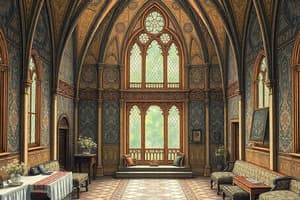Podcast
Questions and Answers
During the Middle Ages, what system emerged as a significant change after the collapse of the Western Roman Empire?
During the Middle Ages, what system emerged as a significant change after the collapse of the Western Roman Empire?
- Mercantilism focused on trade monopolies
- Capitalism based on free market principles
- Socialism with communal ownership
- Feudalism with obligations between lords and vassals (correct)
Which group became central in preserving knowledge and promoting learning during the Middle Ages?
Which group became central in preserving knowledge and promoting learning during the Middle Ages?
- Traders and merchants
- Monks and nuns (correct)
- Soldiers and warriors
- Farmers and peasants
What was the primary form of exchange for holding land in feudalism during the Middle Ages?
What was the primary form of exchange for holding land in feudalism during the Middle Ages?
- Sharing responsibilities
- Bartering goods
- Currency
- Labor or military service (correct)
Which type of community was among the most influential in intellectual pursuits and religious devotion during the Middle Ages?
Which type of community was among the most influential in intellectual pursuits and religious devotion during the Middle Ages?
Which period does the term 'Middle Ages' or 'Medieval Period' generally refer to in European history?
Which period does the term 'Middle Ages' or 'Medieval Period' generally refer to in European history?
What was the primary objective of the Crusades?
What was the primary objective of the Crusades?
Which literary work is associated with vernacular literature in medieval times?
Which literary work is associated with vernacular literature in medieval times?
What was a key factor that led to the emergence of medieval city states?
What was a key factor that led to the emergence of medieval city states?
Which artistic medium thrived during the Middle Ages, showcasing sculpture and painting?
Which artistic medium thrived during the Middle Ages, showcasing sculpture and painting?
What did Gothic architecture achieve during the Middle Ages?
What did Gothic architecture achieve during the Middle Ages?
Flashcards are hidden until you start studying
Study Notes
Medieval History: A Tale of Transition and Triumph
As we delve into the intricate tapestry of human history, our journey takes us through the Middle Ages—a period brimming with change and complexity, often painted by romanticized images yet steeped in genuine struggle and evolution. This chapter spans from around 500 AD to approximately 1500 AD across Europe, encompassing numerous cultural shifts that set the stage for future developments. Here is a glimpse at some salient features within this epoch known as the Middle Ages or Medieval Period.
Rise of Feudalism
Following the collapse of the Western Roman Empire, feudalism emerged as one of the most substantial changes during the early Middle Ages. Based upon mutual obligations between lords and their vassals (or tenants), it established a hierarchical system where land was held in exchange for military service, labor, or revenue. From dukes to knights, the hierarchy granted power and influence while ensuring stability—the bedrock of many nations' foundations.
Christianization and Monastic Orders
The spread of Christianity played a pivotal role in shaping European culture throughout the Middle Ages. As monasteries flourished, monks and nuns became central figures in preserving knowledge, promoting learning, expanding religious practices, and fostering art and architecture. Benedictine abbeys were among the most influential communities contributing to intellectual pursuits and religious devotion.
Crusades
Crusading campaigns marked the transitional phase of the High Middle Ages, beginning around 1096 and lasting almost three centuries. These wars aimed to recapture the Holy Land from Muslim rule, reclaiming Jerusalem for Christendom and spreading Christianity beyond Europe. Although they resulted in mixed outcomes, crusades shaped global relations, giving rise to new trade routes and political alliances.
Scholarship and Literature
In response to spiritual concerns, ecclesiastical scholars like Anselm of Canterbury initiated scholastic philosophy, which fused ancient Greek wisdom with new Christian perspectives. Simultaneously, vernacular literature began appearing, including chivalric romances such as Chrétien de Troyes' Lancelot and Beowulf epics in Old English. Universities also sprouted across Europe, laying the groundwork for academic research and intellectual advancement.
Emergence of City States
Medieval urban centers evolved due to population growth, increased international trade, and more efficient transportation networks. Flourishing city states like Florence, Venice, Genoa, Milan, and Marseille propelled forward economic development, finance, and trade. Their interconnected activities underscored the emergence of regional identities and emphasized the need for diplomatic ties crucial to building stable governments.
Artistic Expression
Artistic expression thrived during the Middle Ages, showcasing the proficient renditions of sculpture, painting, stained glass, metalworking, and illuminated manuscripts. Gothic architecture reached its zenith, manifesting architectural marvels and demonstrating engineering prowess. Efflorescence in narrative arts also led to notable innovations, notably in the field of illustrated manuscripts such as the Bible of Saint Louis and the Très Riches Heures du Duc de Berry.
Reflecting upon these aspects affirms the grandeur and significance of the Middle Ages. Forged under the crucible of societal upheaval and conceptual transformation, this epoch presented profound challenges alongside remarkable achievements. Our understanding of today's world would remain incomplete without contemplating these foundational elements of Medieval history.
Studying That Suits You
Use AI to generate personalized quizzes and flashcards to suit your learning preferences.




